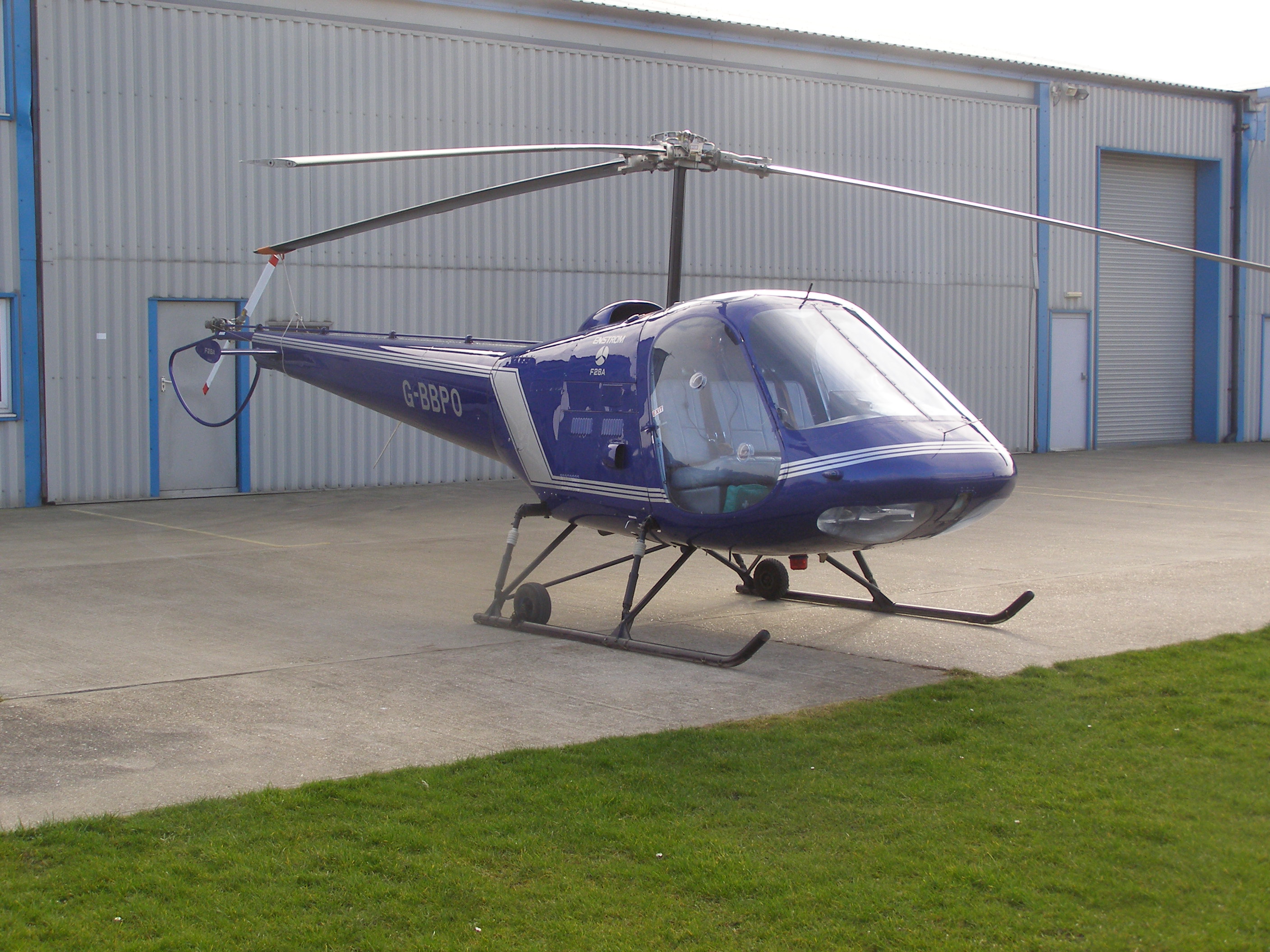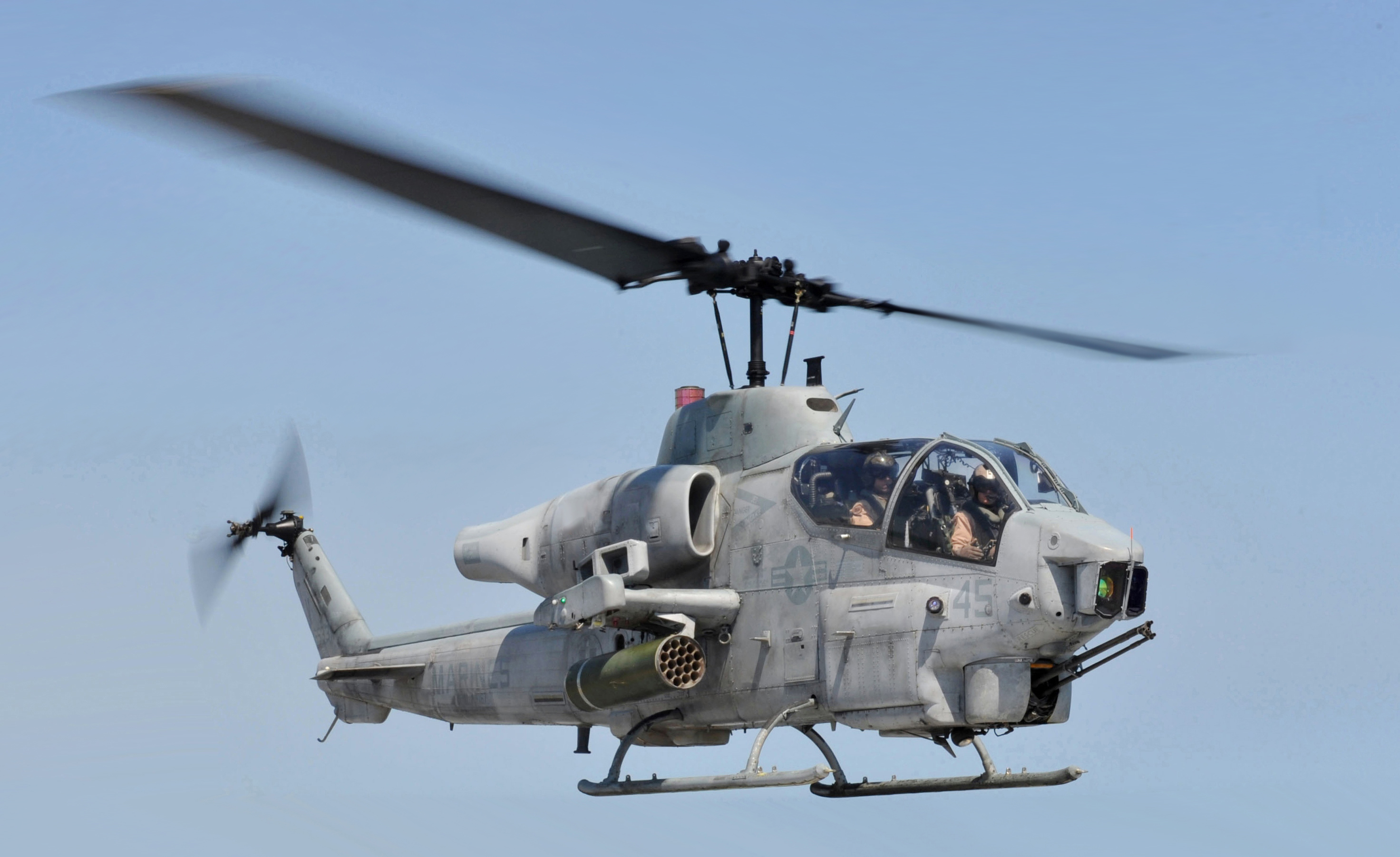|
Swashplate (aeronautics)
A swashplate is a mechanical device that translates input via the helicopter flight controls into motion of the main rotor blades. Because the main rotor blades are spinning, the swashplate is used to transmit three of the pilot's commands from the non-rotating fuselage to the rotating rotor hub and mainblades. Assembly The swashplate consists of two main parts: a stationary swashplate and a rotating swashplate. The stationary (outer) swashplate is mounted on the main rotor mast and is connected to the cyclic and collective controls by a series of pushrods. It is able to tilt in all directions and move vertically. The rotating (inner) swashplate is mounted to the stationary swashplate by means of a bearing and is allowed to rotate with the main rotor mast. An anti-rotation link prevents the inner swash from rotating independently of the blades, which would apply torque to the actuators. The outer swashplate typically has an anti-rotation slider as well to prevent it from ... [...More Info...] [...Related Items...] OR: [Wikipedia] [Google] [Baidu] |
Helicopter Flight Controls
A helicopter pilot manipulates the helicopter flight controls to achieve and maintain controlled aerodynamic flight. Changes to the aircraft flight control system transmit mechanically to the rotor, producing aerodynamic effects on the rotor blades that make the helicopter move in a deliberate way. To tilt forward and back (pitch) or sideways (roll) requires that the controls alter the angle of attack of the main rotor blades ''cyclically'' during rotation, creating differing amounts of lift (force) at different points in the cycle. To increase or decrease overall lift requires that the controls alter the angle of attack for all blades ''collectively'' by equal amounts at the same time, resulting in ascent, descent, acceleration and deceleration. A typical helicopter has three flight control inputs—the cyclic stick, the collective lever, and the anti-torque pedals. Depending on the complexity of the helicopter, the cyclic and collective may be linked together by a ''mixing ... [...More Info...] [...Related Items...] OR: [Wikipedia] [Google] [Baidu] |
Cyclic/collective Pitch Mixing
Cyclic/collective pitch mixing (CCPM) is a control concept employed in collective pitch radio-controlled helicopters. CCPM reduces mechanical complexity and increases precision of control of the helicopter rotor's swashplate. Unlike conventional systems in which a single actuator is responsible for a single axis, CCPM mechanisms allow multiple actuators to work together to manipulate all axis of control. Conventional operation Older model helicopters use three independent servos to manipulate the swashplate. The elevator servo is used to tilt the swashplate forward and aft (longitudinal cyclic), varying the aircraft's pitch. The aileron servo is used to tilt the swashplate left and right (lateral cyclic), varying the aircraft's roll. The collective pitch servo raises and lowers the entire swashplate, varying the collective, and hence the pitch of all the rotor blades collectively. An intermediate mechanical mixing system is used to transfer the control inputs from the servos t ... [...More Info...] [...Related Items...] OR: [Wikipedia] [Google] [Baidu] |
Kaman Aircraft
Kaman Corporation is an American aerospace company, with headquarters in Bloomfield, Connecticut. It was founded in 1945 by Charles Kaman. During the first ten years the company operated exclusively as a designer and manufacturer of several helicopters that set world records and achieved many aviation firsts. In 1956, Kaman began to diversify as an aerospace subcontractor of McDonnell Douglas, Grumman, and others. In the mid-1960s Kaman diversified outside of the aerospace industry, using the expertise Kaman had gained in composite materials and the end of the need for skilled woodworkers to craft wooden rotor blades. Charles Kaman, a guitarist as well as an aerospace pioneer, worked with his engineers and other musicians to create the round-backed, composite-body Ovation guitar, which led to the eventual creation of Kaman Music (now KMCMusicorp). Kaman Music was an independent distributor of musical instruments and accessories, and a major producer of guitars and guitar parts ... [...More Info...] [...Related Items...] OR: [Wikipedia] [Google] [Baidu] |
Enstrom Helicopter
The Enstrom Helicopter Corporation is an American helicopter aerospace manufacturer, based at the Menominee–Marinette Twin County Airport in Michigan, United States. The company was founded in 1959 by mining engineer Rudolph J. "Rudy" Enstrom, initially as the R.J. Enstrom Corp. The company was bought by the Chongqing Helicopter Investment Corporation in 2013 and went out of business in January 2022. Surack Enterprises purchased the company from bankruptcy in May 2022 with the intention of restarting production. History Enstrom began by attempting to design his own helicopter. His lack of training in this area meant that his first efforts were not outstanding, but his efforts were noticed by local Upper Peninsula businessmen, who decided to back him. They recruited several experienced aeronautical engineers, and the group was incorporated as the R.J. Enstrom Co. (1959). The company's first product was the piston-powered F-28 (1965). However, Enstrom had been removed fr ... [...More Info...] [...Related Items...] OR: [Wikipedia] [Google] [Baidu] |
Google Patents
Google Patents is a search engine from Google that indexes patents and patent applications. Contents Google Patents indexes more than 87 million patents and patent applications with full text from 17 patent offices, including: * United States Patent and Trademark Office (USPTO), * European Patent Office (EPO), * China's National Intellectual Property Administration (CNIPA), * Japan Patent Office (JPO), * Korean Intellectual Property Office (KIPO), * World Intellectual Property Organization (WIPO), * Deutsches Patent- und Markenamt (DPMA), * Canadian Intellectual Property Office (CIPO), * Rospatent, * Intellectual Property Office (United Kingdom), * National Institute of Industrial Property (France), * the Netherlands Patent Office, * offices of Spain, Belgium, Denmark, Finland, and Luxembourg. These documents include the entire collection of granted patents and published patent applications from each database (which belong to the public domain). US patent documents date b ... [...More Info...] [...Related Items...] OR: [Wikipedia] [Google] [Baidu] |
Coaxial Rotors
Coaxial rotors or coax rotors are a pair of helicopter rotors mounted one above the other on concentric shafts, with the same axis of rotation, but turning in opposite directions ( contra-rotating). This rotor configuration is a feature of helicopters produced by the Russian Kamov helicopter design bureau. History The idea of coaxial rotors originates with Mikhail Lomonosov. He had developed a small helicopter model with coaxial rotors in July 1754 and demonstrated it to the Russian Academy of Sciences. In 1859, the British Patent Office awarded the first helicopter patent to Henry Bright for his coaxial design. From this point, coaxial helicopters developed into fully operational machines as we know them today. Two pioneering helicopters, the Corradino D'Ascanio-built "D'AT3" of 1930, and the generally more successful French mid-1930s ''Gyroplane Laboratoire'', both used coaxial rotor systems for flight. Design considerations Having two coaxial sets of rotors provides ... [...More Info...] [...Related Items...] OR: [Wikipedia] [Google] [Baidu] |
Raúl Pateras Pescara
Raúl Pateras Pescara de Castelluccio (1890 – 1966), marquis of Pateras-Pescara, was an engineer, lawyer and inventor from Argentina who specialized in automobiles, helicopters and free-piston engines. Pescara is credited for being one of the first people to successfully utilize cyclic pitch, as well as pioneering the use of autorotation for the safe landing of a damaged helicopter. Pescara also set a world record (at the time) in 1924 for achieving a speed of in a helicopter. Biography Pescara was born in Buenos Aires and at the beginning of the 20th century, his family left Argentina to return to Europe. Aircraft In 1911, using a workshop that Pescara was involved with, Gustave Eiffel tested a scale model (1:20) of a seaplane (monoplane design) named the ''Pateras Pescara'', designed by Pescara and Italian engineer Alessandro Guidoni, in a wind tunnel. In 1912, the Italian Ministry of the Navy commissioned Guidoni to build a torpedo bomber based on the Pescara mode ... [...More Info...] [...Related Items...] OR: [Wikipedia] [Google] [Baidu] |
Boris Yuryev
Boris may refer to: People * Boris (given name), a male given name *:''See'': List of people with given name Boris * Boris (surname) * Boris I of Bulgaria (died 907), the first Christian ruler of the First Bulgarian Empire, canonized after his death * Boris II of Bulgaria (c. 931–977), ruler of the First Bulgarian Empire * Boris III of Bulgaria (1894–1943), ruler of the Kingdom of Bulgaria in the first half of the 20th century * Boris, Prince of Tarnovo (born 1997), Spanish-born Bulgarian royal * Boris and Gleb (died 1015), the first saints canonized in Kievan Rus * Boris (singer) (born 1965), pseudonym of French singer Philippe Dhondt Arts and media * Boris (band), a Japanese experimental rock trio * ''Boris'' (EP), by Yezda Urfa, 1975 * "Boris" (song), by the Melvins, 1991 * ''Boris'' (TV series), a 2007–2009 Italian comedy series * '' Boris: The Film'', a 2011 Italian film based on the TV series * '' Boris: The Rise of Boris Johnson'', a 2006 biography by Andrew ... [...More Info...] [...Related Items...] OR: [Wikipedia] [Google] [Baidu] |
Radio-controlled Helicopter
A radio-controlled helicopter (also '' RC helicopter'') is model aircraft which is distinct from a RC airplane because of the differences in construction, aerodynamics, and flight training. Several basic designs of RC helicopters exist, of which some (such as those with collective pitch control) are more maneuverable than others. The more maneuverable designs are often harder to fly, but benefit from greater aerobatic capabilities. Flight controls allow pilots to control the collective (or throttle, on fixed pitch helicopters), the cyclic controls ( pitch and roll), and the tail rotor ( yaw). Controlling these in unison enables the helicopter to perform the same maneuvers as full-sized helicopters, such as hovering and backwards flight, and many other maneuvers that full-sized helicopters cannot, such as inverted flight (where collective pitch control provides negative blade pitch to hold heli up inverted, and pitch/yaw controls must be reversed by pilot). The various helic ... [...More Info...] [...Related Items...] OR: [Wikipedia] [Google] [Baidu] |
Helicopter Rotor
A helicopter main rotor or rotor system is the combination of several rotary wings (rotor blades) with a control system, that generates the aerodynamic lift force that supports the weight of the helicopter, and the thrust that counteracts aerodynamic drag in forward flight. Each main rotor is mounted on a vertical mast over the top of the helicopter, as opposed to a helicopter tail rotor, which connects through a combination of drive shaft(s) and gearboxes along the tail boom. The blade pitch is typically controlled by the pilot using the helicopter flight controls. Helicopters are one example of rotary-wing aircraft ( rotorcraft). The name is derived from the Greek words ''helix'', helik-, meaning spiral; and ''pteron'' meaning wing. Design principles Overview The helicopter rotor is powered by the engine, through the transmission, to the rotating mast. The mast is a cylindrical metal shaft that extends upward from—and is driven by—the transmission. At the top of the m ... [...More Info...] [...Related Items...] OR: [Wikipedia] [Google] [Baidu] |
Collective Pitch
A helicopter pilot manipulates the helicopter flight controls to achieve and maintain controlled aerodynamic flight. Changes to the aircraft flight control system transmit mechanically to the rotor, producing aerodynamic effects on the rotor blades that make the helicopter move in a deliberate way. To tilt forward and back (pitch) or sideways (roll) requires that the controls alter the angle of attack of the main rotor blades ''cyclically'' during rotation, creating differing amounts of lift (force) at different points in the cycle. To increase or decrease overall lift requires that the controls alter the angle of attack for all blades ''collectively'' by equal amounts at the same time, resulting in ascent, descent, acceleration and deceleration. A typical helicopter has three flight control inputs—the cyclic stick, the collective lever, and the anti-torque pedals. Depending on the complexity of the helicopter, the cyclic and collective may be linked together by a ''mixing u ... [...More Info...] [...Related Items...] OR: [Wikipedia] [Google] [Baidu] |




.jpg)